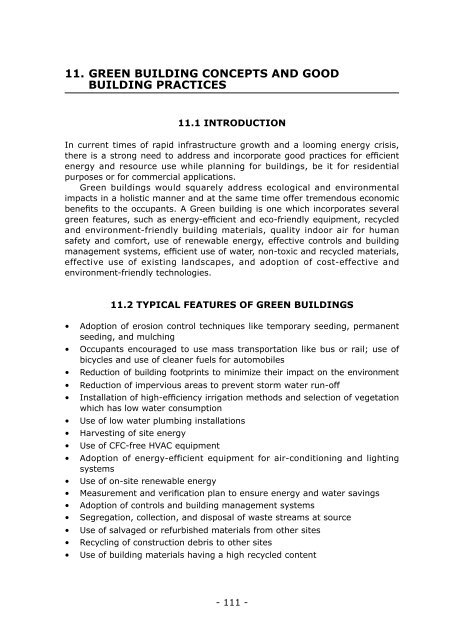Training Manual on Energy Efficiency - APO Asian Productivity ...
Training Manual on Energy Efficiency - APO Asian Productivity ...
Training Manual on Energy Efficiency - APO Asian Productivity ...
Create successful ePaper yourself
Turn your PDF publications into a flip-book with our unique Google optimized e-Paper software.
11. GREEN BUILDING CONCEPTS AND GOOD<br />
BUILDING PRACTICES<br />
11.1 INTRODUCTION<br />
In current times of rapid infrastructure growth and a looming energy crisis,<br />
there is a str<strong>on</strong>g need to address and incorporate good practices for efficient<br />
energy and resource use while planning for buildings, be it for residential<br />
purposes or for commercial applicati<strong>on</strong>s.<br />
Green buildings would squarely address ecological and envir<strong>on</strong>mental<br />
impacts in a holistic manner and at the same time offer tremendous ec<strong>on</strong>omic<br />
benefits to the occupants. A Green building is <strong>on</strong>e which incorporates several<br />
green features, such as energy-efficient and eco-friendly equipment, recycled<br />
and envir<strong>on</strong>ment-friendly building materials, quality indoor air for human<br />
safety and comfort, use of renewable energy, effective c<strong>on</strong>trols and building<br />
management systems, efficient use of water, n<strong>on</strong>-toxic and recycled materials,<br />
effective use of existing landscapes, and adopti<strong>on</strong> of cost-effective and<br />
envir<strong>on</strong>ment-friendly technologies.<br />
11.2 TYPICAL FEATURES OF GREEN BUILDINGS<br />
• Adopti<strong>on</strong> of erosi<strong>on</strong> c<strong>on</strong>trol techniques like temporary seeding, permanent<br />
seeding, and mulching<br />
• Occupants encouraged to use mass transportati<strong>on</strong> like bus or rail; use of<br />
bicycles and use of cleaner fuels for automobiles<br />
• Reducti<strong>on</strong> of building footprints to minimize their impact <strong>on</strong> the envir<strong>on</strong>ment<br />
• Reducti<strong>on</strong> of impervious areas to prevent storm water run-off<br />
• Installati<strong>on</strong> of high-efficiency irrigati<strong>on</strong> methods and selecti<strong>on</strong> of vegetati<strong>on</strong><br />
which has low water c<strong>on</strong>sumpti<strong>on</strong><br />
• Use of low water plumbing installati<strong>on</strong>s<br />
• Harvesting of site energy<br />
• Use of CFC-free HVAC equipment<br />
• Adopti<strong>on</strong> of energy-efficient equipment for air-c<strong>on</strong>diti<strong>on</strong>ing and lighting<br />
systems<br />
• Use of <strong>on</strong>-site renewable energy<br />
• Measurement and verificati<strong>on</strong> plan to ensure energy and water savings<br />
• Adopti<strong>on</strong> of c<strong>on</strong>trols and building management systems<br />
• Segregati<strong>on</strong>, collecti<strong>on</strong>, and disposal of waste streams at source<br />
• Use of salvaged or refurbished materials from other sites<br />
• Recycling of c<strong>on</strong>structi<strong>on</strong> debris to other sites<br />
• Use of building materials having a high recycled c<strong>on</strong>tent<br />
- 111 -
















